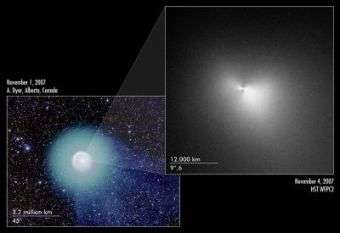Hubble zooms in on heart of mystery comet

Astronomers have used Hubble’s powerful resolution to study Comet Holmes’ core for clues about how the comet brightened. The orbiting observatory’s Wide Field Planetary Camera 2 (WFPC2) monitored the comet for several days, snapping images on 29 Oct., 31 Oct. and 4 Nov. Hubble’s crisp “eye” can see details as small as 54 kilometres across, providing the sharpest view yet of the source of the spectacular brightening.
The Hubble image at right, taken on 4 Nov., shows the heart of the comet. The central portion of the image has been specially processed to highlight variations in the dust distribution near the nucleus. About twice as much dust lies along the east-west direction (the horizontal direction) as along the north-south direction (the vertical direction), giving the comet a “bow tie” appearance.
The composite colour image at left, taken Nov. 1 by the amateur astronomer Alan Dyer, shows the complex structure of the entire coma, consisting of concentric shells of dust and a faint tail emanating from the comet’s right side.
The nucleus — the small solid body that is the source of the comet’s activity — is still swaddled in bright dust, even 12 days after the spectacular outburst. “Most of what Hubble sees is sunlight scattered from microscopic particles,” explained Hal Weaver of The Johns Hopkins University Applied Physics Laboratory of Laurel, Maryland in the USA, who led the Hubble investigation. “But we may finally be starting to detect the emergence of the nucleus itself in this final Hubble image.”
Hubble first observed Comet 17P/Holmes on June 15, 1999, when there was virtually no dusty shroud around the nucleus. Although Hubble cannot resolve the nucleus, astronomers inferred its size by measuring its brightness. Astronomers deduced that the nucleus’s diameter was approximately 3.4 kilometres, about the distance between the Arc de Triomphe and the Louvre glass pyramid in Paris. They hope to use the new Hubble images to determine the size of the comet’s nucleus to see how much of it was blasted away during the outburst.
Hubble’s two earlier snapshots of Comet Holmes also showed some interesting features. On 29 Oct. the telescope spied three “spurs” of dust emanating from the nucleus while the Hubble images taken on 31 Oct. revealed an outburst of dust just west of the nucleus.
The Hubble images however do not show any large fragments near the nucleus of Comet Holmes, unlike the case of Comet 73P/Schwassmann-Wachmann 3 (SW3). In the spring of 2006 Hubble observations revealed a multitude of “mini-comets” ejected by SW3 after the comet increased dramatically in brightness.
Ground-based images of Comet Holmes show a large, spherically symmetrical cloud of dust that is offset from the nucleus, suggesting that a large fragment broke off and subsequently disintegrated into tiny dust particles after moving away from the main nucleus. Unfortunately, the huge amount of dust near the comet’s nucleus and the relatively large distance from Earth (240 million kilometres, or 1.6 astronomical units for Holmes versus 15 million kilometres, 0.1 astronomical units for SW3), conspire to make detecting fragments near Holmes nearly impossible right now, unless the fragments are nearly as large as the nucleus itself.
Source: Hubble Information Centre




















